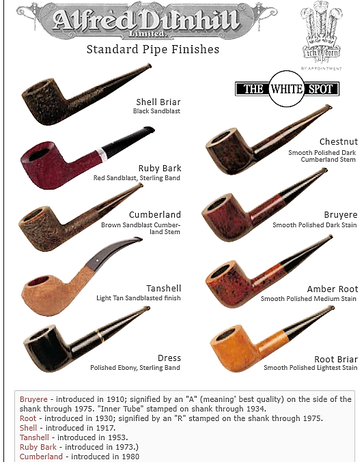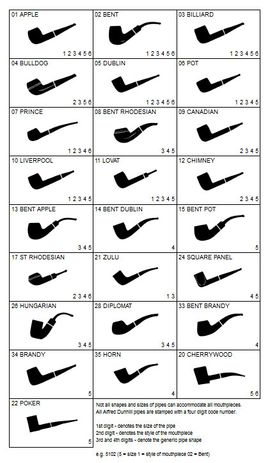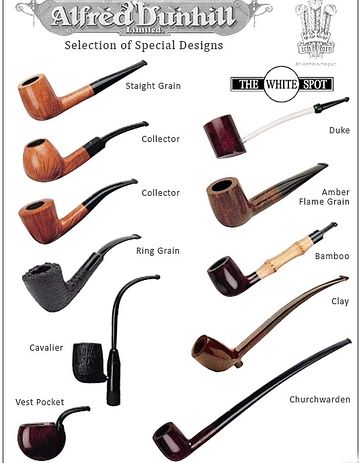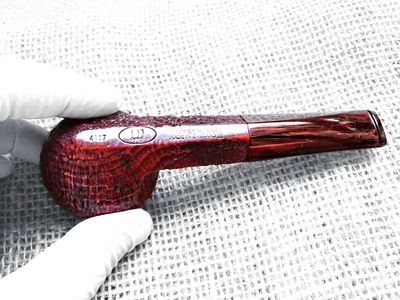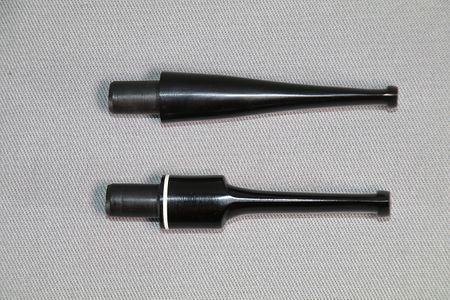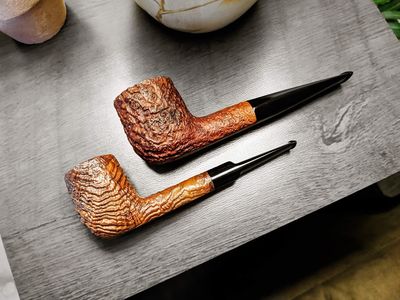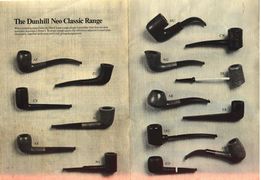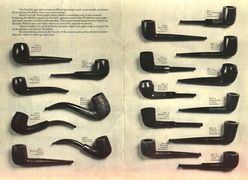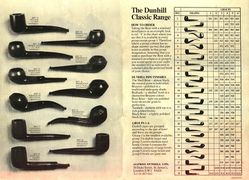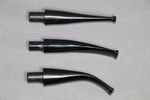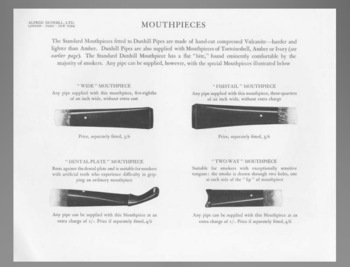Tableau des formes Dunhill
A l'heure actuelle il y a 35 formes courantes, avec une classification par des numéros à deux chiffres. Parfois un bout de bruyère doit être taillé selon une forme qui n'appartient pas à la liste standard. Une telle pipe est appelée "Quaint"; Le système actuel à 4 chiffres apparent est maintenant en place depuis plus de 30 ans et a montré son efficacité à la fois pour Dunhill, le marché et les clients.
| Example: 4117 | (4: groupe; 1: tuyau fuselé; 17: forme rhodésienne droite* - critères Dunhil. |
En dépit de la rareté de la belle bruyère, qui a toujours nécessité d'ajuster le prix des Dunhill en fonction du coût de la bruyère employée dans l'usine, il est important de se souvenir qu'indépendamment de la taille et du prix, il n'y a qu'une seule qualité – la meilleure. Les têtes sont triées en 6 groupes.
| Groupe 1 / Petit | Groupe 2 / Petit à Moyen | Groupe 3 / Moyen | Groupe 4 / Moyen à Grand |
| Groupe 5 / Grand | Groupe 6 / Grand à Super Grand | XL / Super Grand | XXL or Giant |
"La taille d'un groupe donné va égalemet dépendre de la forme de la pipe, i.e. les dimenssions d'une Billiard de groupe 4 seront nettement différentes des dimensions d'une Pot ou d'une Chimney du même groupe. Mais aussi, même au sein du groupe de taille et pour une forme donnée (disons une Billard de groupe 4) il y aura toujours des variantes pour une multitude de raisons. Pour en citer quelques unes :
- Les pipes sont pour une grande partie faites à la main, aussi, et c'est naturel, il y aura toujours de légères différences de dimensions;
- On peut faire des variantes d'une forme données (qui seront toutes catégorisées comme Billiard de Groupe 4), c.a.d. qu'on peut avoir une Billiard standard, ou une Billiard de forme davantage "Barrel" ("tonneau" c.a.d. cylindrique)ou une billiard au bord biseauté ou encore une billiard à tige ovale…tout ce qui fera que ces pipes se différencieront l'une de l'autre en termes de dimensions;
- Nous travaillons et retravaillons nos pipes sans relâche pour éliminer autant que possible les défauts, ce qui peut également avoir certains effets sur les dimensions d'une pipe;
- Les pipes sablées seront légèrement plus petites par rapport à une pipe identique en finition lisse, du fait du sablage, qui, même légèrement, réduira les dimensions totales (et le poids) de la pipe.
La liste ci-dessus n'est pas exhaustive mais donne un bon aperçu des raisons pour lesquelles il n'existe pas de dimensions strictes pour nos pipes". Hener, K. S., Product Line Director - The White Spot Smoker's Accessory Division and Walthamstow site (January, 2020).
Le chiffre entouré indique la taille du foyer (1 par exemple, est le plus petit). Il est habituellement suivi par une lettre corresondant à la finition de la pipe. Ce chiffre / lettre a été introduit aux alentours de 1952 et a été abandonné vers 1976 et remplacé par un code à 4 ou 5 chiffres. Il a été réintroduit en mars 2012, mais uniquement pour les versions commémoratives.

|

|

|

|

|

|
The original skus/model numbers from the 1920’s until the early 1970’s stood for very specific shapes and bowls. For example, the codes 31, 34, 59, 111, 113, 117, 196, LB, LBS... were all different types of Billiard shaped pipes and there were about 50(!), such codes for the Billiard shape alone.
| CH - Skater | CK - Bent Rhodesian | SS - “Quaint Shape” Billiard hexagonal shank & tapered bit 1928 |
| EC - “Quaint Shape” Canadian, oval shank, short tapered bit 1928 | FR - “Quaint Shape” Octagonal panel billiard, round shank, extended tapered bit 1928 | OE - “Quaint Shape” Octagonal panel billiard, square shank, angled tapered bit 1928 |
| O - Squat Bulldog | OR - Straight Rhodesian | OX - Saddle Bulldog |
| OXS - Bulldog | P - 1/2 Bent Bulldog | PO - 1/4 Bent Bulldog |
| EK - “Quaint Shape” Hexagonal panel billiard, square shank, angled tapered bit “Stand-up” 1928 | VT - “Quaint Shape” tirangular panel billiard, tirangular shank and bit “Stand-up” 1928 | SA - “Quaint Shape” octogonal tall panel billiard, hexagonal shank, angled bit “Stand-up” 1928 |
| GD - “Quaint Shape” Circular tall billiard, ringed low at bowl base, round shank and bit 1928 | PK - “Quaint Shape” Four sided panel billiard, diamond shank and bit 1928 | PL - “Quaint Shape” Four sided panel billiard,triangular shank and bit 1928 |
| EL - “Quaint Shape” Four sided panel billiard, triangular shank and bit 1928 | ES - Canadian | HB - Bent |
| HU - Hungarian | FJ - “Quaint Shape” Cutty, canted round bowl, extended tapered bit 1928 | KS - “Quaint Shape” Apple, flattened bowl support peg “Stand-up” 1928 |
| K - “Quaint Shape” Round Apple, converging rim, round shank, tapered bit 1928 | KB - Urn (Quaint shape) | FE - “Quaint Shape” Apple, large squat bowl, round shank, extended tapered bit 1928 |
| FET - “Quaint Shape” Apple, large squat bowl, round shank, extended tapered bit 1928 | E - “Quaint Shape” Army mount (silver) large squat bowl, round shank, extended tapered bit 1928 | ET - “Quaint Shape” Army mount (silver) large squat bowl, round shank, extended tapered bit 1928 |
| EK - Paneled billiard 1950, 1969 | LV - Straight Brandy | LB - Long Billiard |
| LBS - Billiard (Longer) | LC - Large Curve | LF - Dublin |
| LOX - Bulldog | U - Shield Bulldog | US - Beehive - Quaint shape |
| UT - Quaint shape | R - Pot | SU - Barrel |
| TLY - Bent Billiard (large) - Saddle Stem. | VS - Brandy | W - Bamboo |
- Eric Boehm offers to us a list of the principals shapes: 2-digits and ODA list by Loring: Dunhill Shapes List
A 3-digit system (“Interim”) was developed that showed a logical approach to identify pipes in terms of size, mouthpiece, and shape, with the 1st digit being the size, the 2nd digit the mouthpiece, and the 3rd digit the shape, i.e. the old “85” became a “321” which was a group 3 Apple with taper mouthpiece. This was soon to be replaced by a more detailed, formal 4- and 5-digit system around 1978.
The first image on the right, (with the shape number 577) falls into this system, so 577 has no special meaning apart from describing/being the model for that particular pipe shape (in this case a specific group 2 Billiard with saddle mouthpiece). Around 1973, with the introduction of computers, new categories were introduced that indicated size, mouthpiece, and shape. As for the “T”, in 1952 a full-size “T” was added after the circled group size stamp to further describe the Tanshell finish (in 1953 the “T” was reduced to about half the size). So this pipe dates from 1952.
The 5th digit indicated the style of the bowl within the group of a similar classification, each identified by the last digit, which could be any number between 1-9.
While e.g. within the Gp.4 Billiard there were 5 different styles of bowls (5th digit being either 1,2,3,4, or 9), for a Gp.1 Billiard there were only 3 styles used (5th digit being 1, 2, or 9).
Although the 5-digit code was stamped on the pipe and thus was visible to the consumer, it was mostly used for internal production planning purposes and to a lesser extent for retail staff. The system proved to be quite complex.
The elimination of the 5th digit on the pipes (in 1984) resulted in better management of the pipe stock as there were less skus and it also facilitated the work for the sales staff in the retail shops as the complexity and number of skus was considerably reduced.
- |*Numbers 7 & 8 are not used nowadays as The White Spot now make all mouthpieces as fishtail as standard practise.
- | When 5 digits occur, the meaning of the 4 first remain the same.
- | 5 digit shape numbers was added in 1976 and ended in 1984.
- | Some sources such as the Pipephil portal, indicate this change in markings occurred in mid-1976, others indicate it was 1974.
- | Before 2007 there were only two classifications for mouthpieces (1= tapered, 2= saddle). After this period, 9 patterns are used (4303, 3903, 5403,...). Today only 7.
- | Usually pipes with fishtail bit receive a stamp (FT) next to the shape number.
- | In the encircled group number, letter corresponding to the pipe finish: “S” for Shell; “A” for Bruyere; “T” for Tanshell and “R/B” for Red Bark. *9mm its about filter.
- | 120, 196, P, R are old shape names from the '20s and '30s, which the Dunhill reintroduced for the White Spot Collection only.
- | "F/T" (fishtail) mouthpiece was designed only in the 1930's.
Special thanks to Mr. Hener (The White Spot Division) for his valuable contributions.
Yang (talk) 11:11, 7 January 2020 (CST)
